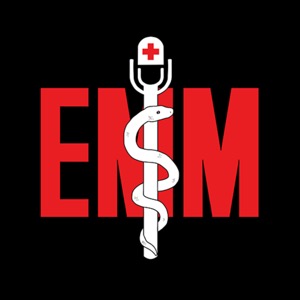Podcast 914: Neuroleptic Malignant Syndrome (NMS)
Emergency Medical Minute - A podcast by Emergency Medical Minute - Mondays

Contributor: Taylor Lynch, MD Educational Pearls: What is NMS? Neuroleptic Malignant Syndrome Caused by anti-dopamine medication or rapid withdrawal of pro-dopamenergic medications Mechanism is poorly understood Life threatening What medications can cause it? Typical antipsychotics Haloperidol, chlorpromazine, prochlorperazine, fluphenazine, trifluoperazine Atypical antipsychotics Less risk Risperidone, clozapine, quetiapine, olanzapine, aripiprazole, ziprasidone Anti-emetic agents with anti dopamine activity Metoclopramide, promethazine, haloperidol Not ondansetron Abrupt withdrawal of levodopa How does it present? Slowly over 1-3 days (unlike serotonin syndrome which has a more acute onset) Altered mental status, 82% of patients, typically agitated delirium with confusion Peripheral muscle rigidity and decreased reflexes. AKA lead pipe rigidity. (As opposed to clonus and hyperreflexia in serotonin syndrome) Hyperthermia (>38C seen in 87% of patients) Can also have tachycardia, labile blood pressures, tachypnea, and tremor How is it diagnosed? Clinical diagnosis, focus on the timing of symptoms No confirmatory lab test but can see possible elevated CK levels and WBC of 10-40k with a left shift What else might be on the differential? Sepsis CNS infections Heat stroke Agitated delirium Status eptilepticus Drug induced extrapyramidal symptoms Serotonin syndrome Malignant hyperthermia What is the treatment? Start with ABC’s Stop all anti-dopaminergic meds and restart pro-dopamine meds if recently stopped Maintain urine output with IV fluids if needed to avoid rhabdomyolysis Active or passive cooling if needed Benzodiazapines, such as lorazepam 1-2 mg IV q 4hrs What are active medical therapies? Controversial treatments Bromocriptine, dopamine agonist Dantrolene, classically used for malignant hyperthermia Amantadine, increases dopamine release Use as a last resort Dispo? Mortality is around 10% if not recognized and treated Most patients recover in 2-14 days Must wait 2 weeks before restarting any medications References Oruch, R., Pryme, I. F., Engelsen, B. A., & Lund, A. (2017). Neuroleptic malignant syndrome: an easily overlooked neurologic emergency. Neuropsychiatric disease and treatment, 13, 161–175. https://doi.org/10.2147/NDT.S118438 Tormoehlen, L. M., & Rusyniak, D. E. (2018). Neuroleptic malignant syndrome and serotonin syndrome. Handbook of clinical neurology, 157, 663–675. https://doi.org/10.1016/B978-0-444-64074-1.00039-2 Velamoor, V. R., Norman, R. M., Caroff, S. N., Mann, S. C., Sullivan, K. A., & Antelo, R. E. (1994). Progression of symptoms in neuroleptic malignant syndrome. The Journal of nervous and mental disease, 182(3), 168–173. https://doi.org/10.1097/00005053-199403000-00007 Ware, M. R., Feller, D. B., & Hall, K. L. (2018). Neuroleptic Malignant Syndrome: Diagnosis and Management. The primary care companion for CNS disorders, 20(1), 17r02185. https://doi.org/10.4088/PCC.17r02185 Summarized by Jeffrey Olson MS2 | Edited by Meg Joyce & Jorge Chalit, OMSIII
